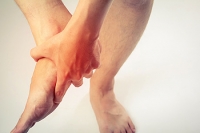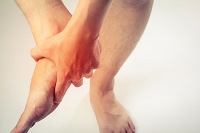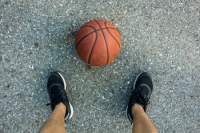
Blog (807)
Actor Mario Lopez Injures Achilles Tendon
TV host Mario Lopez suffered a serious injury on the fourth of July. His snapchat update revealed that the actor ruptured his Achilles tendon. Along with the photo, Lopez wrote a caption that read, “Celebrating the 4th in the E.R…Tore my achilles sparring. Ugh.. So frustrated.” Three days later, he posted a picture of himself giving a thumbs-up after the success of his surgery. The recovery period for Lopez’s injury is expected to be approximately four to six months. Achilles tendon injuries affect the back of the lower leg. An overstretch of this tendon can either tear partially or completely. Many people who tear their Achilles tendons hear a popping sound after suffering the injury. If you are experiencing pain in your Achilles tendon, you should seek treatment from your podiatrist.
Achilles tendon injuries need immediate attention to avoid future complications. If you have any concerns, contact Dr. Kenneth Donovan of Advanced Care Foot and Ankle. Our doctor can provide the care you need to keep you pain-free and on your feet.
What Is the Achilles Tendon?
The Achilles tendon is a tendon that connects the lower leg muscles and calf to the heel of the foot. It is the strongest tendon in the human body and is essential for making movement possible. Because this tendon is such an integral part of the body, any injuries to it can create immense difficulties and should immediately be presented to a doctor.
What Are the Symptoms of an Achilles Tendon Injury?
There are various types of injuries that can affect the Achilles tendon. The two most common injuries are Achilles tendinitis and ruptures of the tendon.
Achilles Tendinitis Symptoms
- Inflammation
- Dull to severe pain
- Increased blood flow to the tendon
- Thickening of the tendon
Rupture Symptoms
- Extreme pain and swelling in the foot
- Total immobility
Treatment and Prevention
Achilles tendon injuries are diagnosed by a thorough physical evaluation, which can include an MRI. Treatment involves rest, physical therapy, and in some cases, surgery. However, various preventative measures can be taken to avoid these injuries, such as:
- Thorough stretching of the tendon before and after exercise
- Strengthening exercises like calf raises, squats, leg curls, leg extensions, leg raises, lunges, and leg presses
If you have any questions please feel free to contact one of our offices located in Warren, Livingston, and Toms River, NJ. We offer the newest diagnostic tools and technology to treat your foot and ankle needs.
Actor Mario Lopez Injures Achilles Tendon
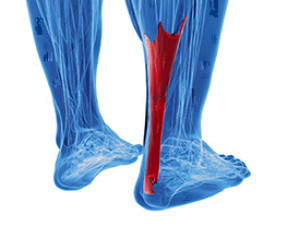 TV host Mario Lopez suffered a serious injury on the fourth of July. His snapchat update revealed that the actor ruptured his Achilles tendon. Along with the photo, Lopez wrote a caption that read, “Celebrating the 4th in the E.R...Tore my achilles sparring. Ugh.. So frustrated.” Three days later, he posted a picture of himself giving a thumbs-up after the success of his surgery. The recovery period for Lopez’s injury is expected to be approximately four to six months. Achilles tendon injuries affect the back of the lower leg. An overstretch of this tendon can either tear partially or completely. Many people who tear their Achilles tendons hear a popping sound after suffering the injury. If you are experiencing pain in your Achilles tendon, you should seek treatment from your podiatrist.
TV host Mario Lopez suffered a serious injury on the fourth of July. His snapchat update revealed that the actor ruptured his Achilles tendon. Along with the photo, Lopez wrote a caption that read, “Celebrating the 4th in the E.R...Tore my achilles sparring. Ugh.. So frustrated.” Three days later, he posted a picture of himself giving a thumbs-up after the success of his surgery. The recovery period for Lopez’s injury is expected to be approximately four to six months. Achilles tendon injuries affect the back of the lower leg. An overstretch of this tendon can either tear partially or completely. Many people who tear their Achilles tendons hear a popping sound after suffering the injury. If you are experiencing pain in your Achilles tendon, you should seek treatment from your podiatrist.
Achilles tendon injuries need immediate attention to avoid future complications. If you have any concerns, contact Dr. Kenneth Donovan of Advanced Care Foot and Ankle. Our doctor can provide the care you need to keep you pain-free and on your feet.
What Is the Achilles Tendon?
The Achilles tendon is a tendon that connects the lower leg muscles and calf to the heel of the foot. It is the strongest tendon in the human body and is essential for making movement possible. Because this tendon is such an integral part of the body, any injuries to it can create immense difficulties and should immediately be presented to a doctor.
What Are the Symptoms of an Achilles Tendon Injury?
There are various types of injuries that can affect the Achilles tendon. The two most common injuries are Achilles tendinitis and ruptures of the tendon.
Achilles Tendinitis Symptoms
- Inflammation
- Dull to severe pain
- Increased blood flow to the tendon
- Thickening of the tendon
Rupture Symptoms
- Extreme pain and swelling in the foot
- Total immobility
Treatment and Prevention
Achilles tendon injuries are diagnosed by a thorough physical evaluation, which can include an MRI. Treatment involves rest, physical therapy, and in some cases, surgery. However, various preventative measures can be taken to avoid these injuries, such as:
- Thorough stretching of the tendon before and after exercise
- Strengthening exercises like calf raises, squats, leg curls, leg extensions, leg raises, lunges, and leg presses
If you have any questions please feel free to contact one of our offices located in Warren, Livingston, and Toms River, NJ . We offer the newest diagnostic tools and technology to treat your foot and ankle needs.
It’s Time for Beautiful Feet
It's Time for Beautiful Feet
What are the Causes of Neuropathy?
A condition referred to as peripheral neuropathy typically occurs as a result of malfunctioning nerves that are damaged. This condition may be caused by an inherited gene, an injury, or an infection. It has been known to cause discomfort and pain, a tingling feeling in the feet, in addition to a sensation of heaviness in the lower limbs. Recent research has shown that approximately 60 percent of diabetic patients experience some type of nerve damage, which may often be a result of elevated blood sugar levels. To determine the severity of neuropathy, there are several tests that may be performed. These may include undergoing an MRI, which may determine if a tumor or disc is pressing on a nerve, an electromyography, which is used to evaluate the body’s nerve signals, or a nerve conduction study, which may aid in assessing the nerves for correct transmitting information. If you are afflicted with neuropathy, it’s suggested to consult with a podiatrist as quickly as possible for additional information.
Neuropathy
Neuropathy can be a potentially serious condition, especially if it is left undiagnosed. If you have any concerns that you may be experiencing nerve loss in your feet, consult with Dr. Kenneth Donovan from Advanced Care Foot and Ankle. Our doctor will assess your condition and provide you with quality foot and ankle treatment for neuropathy.
What Is Neuropathy?
Neuropathy is a condition that leads to damage to the nerves in the body. Peripheral neuropathy, or neuropathy that affects your peripheral nervous system, usually occurs in the feet. Neuropathy can be triggered by a number of different causes. Such causes include diabetes, infections, cancers, disorders, and toxic substances.
Symptoms of Neuropathy Include:
- Numbness
- Sensation loss
- Prickling and tingling sensations
- Throbbing, freezing, burning pains
- Muscle weakness
Those with diabetes are at serious risk due to being unable to feel an ulcer on their feet. Diabetics usually also suffer from poor blood circulation. This can lead to the wound not healing, infections occurring, and the limb may have to be amputated.
Treatment
To treat neuropathy in the foot, podiatrists will first diagnose the cause of the neuropathy. Figuring out the underlying cause of the neuropathy will allow the podiatrist to prescribe the best treatment, whether it be caused by diabetes, toxic substance exposure, infection, etc. If the nerve has not died, then it’s possible that sensation may be able to return to the foot.
Pain medication may be issued for pain. Electrical nerve stimulation can be used to stimulate nerves. If the neuropathy is caused from pressure on the nerves, then surgery may be necessary.
If you have any questions, please feel free to contact one of our offices located in Warren, Livingston, and Toms River, NJ. We offer the newest diagnostic and treatment technologies for all your foot care needs.
What are the Causes of Neuropathy?
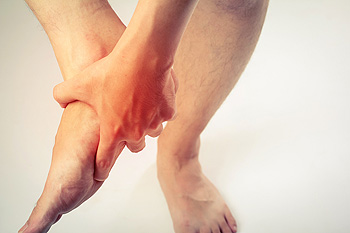 A condition referred to as peripheral neuropathy typically occurs as a result of malfunctioning nerves that are damaged. This condition may be caused by an inherited gene, an injury, or an infection. It has been known to cause discomfort and pain, a tingling feeling in the feet, in addition to a sensation of heaviness in the lower limbs. Recent research has shown that approximately 60 percent of diabetic patients experience some type of nerve damage, which may often be a result of elevated blood sugar levels. To determine the severity of neuropathy, there are several tests that may be performed. These may include undergoing an MRI, which may determine if a tumor or disc is pressing on a nerve, an electromyography, which is used to evaluate the body’s nerve signals, or a nerve conduction study, which may aid in assessing the nerves for correct transmitting information. If you are afflicted with neuropathy, it’s suggested to consult with a podiatrist as quickly as possible for additional information.
A condition referred to as peripheral neuropathy typically occurs as a result of malfunctioning nerves that are damaged. This condition may be caused by an inherited gene, an injury, or an infection. It has been known to cause discomfort and pain, a tingling feeling in the feet, in addition to a sensation of heaviness in the lower limbs. Recent research has shown that approximately 60 percent of diabetic patients experience some type of nerve damage, which may often be a result of elevated blood sugar levels. To determine the severity of neuropathy, there are several tests that may be performed. These may include undergoing an MRI, which may determine if a tumor or disc is pressing on a nerve, an electromyography, which is used to evaluate the body’s nerve signals, or a nerve conduction study, which may aid in assessing the nerves for correct transmitting information. If you are afflicted with neuropathy, it’s suggested to consult with a podiatrist as quickly as possible for additional information.
Neuropathy
Neuropathy can be a potentially serious condition, especially if it is left undiagnosed. If you have any concerns that you may be experiencing nerve loss in your feet, consult with Dr. Kenneth Donovan from Advanced Care Foot and Ankle. Our doctor will assess your condition and provide you with quality foot and ankle treatment for neuropathy.
What Is Neuropathy?
Neuropathy is a condition that leads to damage to the nerves in the body. Peripheral neuropathy, or neuropathy that affects your peripheral nervous system, usually occurs in the feet. Neuropathy can be triggered by a number of different causes. Such causes include diabetes, infections, cancers, disorders, and toxic substances.
Symptoms of Neuropathy Include:
- Numbness
- Sensation loss
- Prickling and tingling sensations
- Throbbing, freezing, burning pains
- Muscle weakness
Those with diabetes are at serious risk due to being unable to feel an ulcer on their feet. Diabetics usually also suffer from poor blood circulation. This can lead to the wound not healing, infections occurring, and the limb may have to be amputated.
Treatment
To treat neuropathy in the foot, podiatrists will first diagnose the cause of the neuropathy. Figuring out the underlying cause of the neuropathy will allow the podiatrist to prescribe the best treatment, whether it be caused by diabetes, toxic substance exposure, infection, etc. If the nerve has not died, then it’s possible that sensation may be able to return to the foot.
Pain medication may be issued for pain. Electrical nerve stimulation can be used to stimulate nerves. If the neuropathy is caused from pressure on the nerves, then surgery may be necessary.
If you have any questions, please feel free to contact one of our offices located in Warren, Livingston, and Toms River, NJ . We offer the newest diagnostic and treatment technologies for all your foot care needs.
Read more about NeuropathyWhy it May be Beneficial for Athletes to Play Multiple Sports
Each year, approximately 1.5 million children suffer some sort of sports injury. Research has found that kids who are only involved in one sport are more likely to suffer serious injuries compared to those who play different sports. A study was conducted on NBA draft picks to see which players played multiple sports in high school and which players only played basketball. Those who conducted the study looked to see if the amount of sports an athlete played had any impact on the amount of injuries they had. The benefit of playing a variety of sports is that the body is forced to use different ligaments and muscles instead of overusing and straining the same muscles that are used in one sport. The idea is that a player will perform better in a single sport if he exercises other muscles in addition to the ones that are typically used in that sport.
Ankle and foot injuries are common among athletes and in many sports. They can be caused by several problems and may be potentially serious. If you are feeling pain or think you were injured in a sporting event or when exercising, consult with Dr. Kenneth Donovan from Advanced Care Foot and Ankle. Our doctor will assess your condition and provide you with quality foot and ankle treatment.
Common Injuries
The most common injuries that occur in sporting activities include:
- Achilles Tendonitis
- Achilles Tendon Rupture
- Ankle Sprains
- Broken Foot
- Plantar Fasciitis
- Stress Fractures
- Turf Toe
Symptoms
Symptoms vary depending upon the injury and in some cases, there may be no symptoms at all. However, in most cases, some form of symptom is experienced. Pain, aching, burning, bruising, tenderness, tightness or stiffness, sensation loss, difficulty moving, and swelling are the most common symptoms.
Treatment
Just as symptoms vary depending upon the injury, so do treatment options. A common treatment method is known as the RICE method. This method involves rest, applying ice, compression and elevating the afflicted foot or ankle. If the injury appears to be more serious, surgery might be required, such as arthroscopic or reconstructive surgery. Lastly, rehabilitation or therapy might be needed to gain full functionality in the afflicted area. Any discomfort experienced by an athlete must be evaluated by a licensed, reputable medical professional.
If you have any questions, please feel free to contact one of our offices located in Warren, Livingston, and Toms River, NJ. We offer the newest diagnostic and treatment technologies for all your foot care needs.
How to Find Shoes That Fit Perfectly
The importance of buying the correct size shoe is crucial to the overall health of the foot. An object that is referred to as the Brannock shoe measuring device is designed to determine the exact size of your foot. This is found in most shoe stores and has proven to be an effective way to choose the right size shoe. Most people will have one foot that is larger than the other and this may typically be due to an inherited trait. Additionally, shoe sizes may change as a result of specific foot conditions such as bunions or hammertoes. Pregnancy will generally affect the size of the foot, and may become wider and longer because of weakened ligaments. Research has shown that buying shoes during the middle of the day is beneficial in finding the perfect fit, because the feet are generally larger during this time of day. It may be beneficial to notice what material the soles are made of, which may help in preventing any type of sharp object from penetrating the shoe.
Finding a properly-fitting shoe is important in reducing injuries and preventing foot problems. For more information about treatment, contact Dr. Kenneth Donovan from Advanced Care Foot and Ankle. Our doctor will treat your foot and ankle needs.
Proper Shoe Fitting
A common concern when it comes to foot health, having properly fitted shoes can help prevent injuries to the foot. Out feet affect our posture and gait, which in turn affects the biomechanics and overall bodily structure. With 33 joints, 26 bones, and over 100 ligaments, the potential for serious injury is much greater than one realizes. Although the feet cease growth in adulthood, they still change shape as they mature. Here are some factors to consider when it comes to investing in proper fitting shoes:
- Be sure the shoes fit correctly right away
- Ensure the ball of your foot fits comfortably in the widest portion of the shoes
- Even though they may look fashionable, improper fitting shoes can either create adverse conditions or exacerbate existing ones you may already have
- Walk along a carpeted surface to ensure the shoes comfortably fit during normal activity
Keeping in mind how shoes fit the biomechanics of your body, properly-fitting shoes are vitally important. Fortunately, it is not difficult to acquire footwear that fits correctly. Be sure to wear shoes that support the overall structure of your body. Do your feet a favor and invest in several pairs of well-fitted shoes today.
If you have any questions please feel free to contact one of our offices located in Warren, Livingston, and Toms River, NJ. We offer the newest diagnostic and treatment technologies for all your foot and ankle needs.
How to Find Shoes That Fit Perfectly
 The importance of buying the correct size shoe is crucial to the overall health of the foot. An object that is referred to as the Brannock shoe measuring device is designed to determine the exact size of your foot. This is found in most shoe stores and has proven to be an effective way to choose the right size shoe. Most people will have one foot that is larger than the other and this may typically be due to an inherited trait. Additionally, shoe sizes may change as a result of specific foot conditions such as bunions or hammertoes. Pregnancy will generally affect the size of the foot, and may become wider and longer because of weakened ligaments. Research has shown that buying shoes during the middle of the day is beneficial in finding the perfect fit, because the feet are generally larger during this time of day. It may be beneficial to notice what material the soles are made of, which may help in preventing any type of sharp object from penetrating the shoe.
The importance of buying the correct size shoe is crucial to the overall health of the foot. An object that is referred to as the Brannock shoe measuring device is designed to determine the exact size of your foot. This is found in most shoe stores and has proven to be an effective way to choose the right size shoe. Most people will have one foot that is larger than the other and this may typically be due to an inherited trait. Additionally, shoe sizes may change as a result of specific foot conditions such as bunions or hammertoes. Pregnancy will generally affect the size of the foot, and may become wider and longer because of weakened ligaments. Research has shown that buying shoes during the middle of the day is beneficial in finding the perfect fit, because the feet are generally larger during this time of day. It may be beneficial to notice what material the soles are made of, which may help in preventing any type of sharp object from penetrating the shoe.
Finding a properly-fitting shoe is important in reducing injuries and preventing foot problems. For more information about treatment, contact Dr. Kenneth Donovan from Advanced Care Foot and Ankle. Our doctor will treat your foot and ankle needs.
Proper Shoe Fitting
A common concern when it comes to foot health, having properly fitted shoes can help prevent injuries to the foot. Out feet affect our posture and gait, which in turn affects the biomechanics and overall bodily structure. With 33 joints, 26 bones, and over 100 ligaments, the potential for serious injury is much greater than one realizes. Although the feet cease growth in adulthood, they still change shape as they mature. Here are some factors to consider when it comes to investing in proper fitting shoes:
- Be sure the shoes fit correctly right away
- Ensure the ball of your foot fits comfortably in the widest portion of the shoes
- Even though they may look fashionable, improper fitting shoes can either create adverse conditions or exacerbate existing ones you may already have
- Walk along a carpeted surface to ensure the shoes comfortably fit during normal activity
Keeping in mind how shoes fit the biomechanics of your body, properly-fitting shoes are vitally important. Fortunately, it is not difficult to acquire footwear that fits correctly. Be sure to wear shoes that support the overall structure of your body. Do your feet a favor and invest in several pairs of well-fitted shoes today.
If you have any questions please feel free to contact one of our offices located in Warren, Livingston, and Toms River, NJ . We offer the newest diagnostic and treatment technologies for all your foot and ankle needs.
Read more about Proper Shoe Fitting




